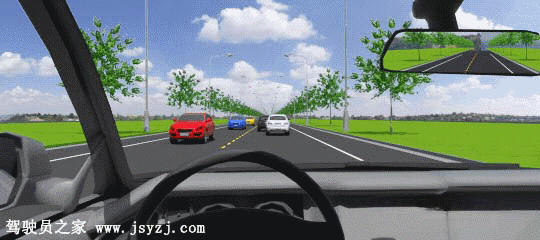1、When extinguishing a fire, the driver should refrain from breathing through mouth or crying loudly Otherwise, the fire and smoke will scorch the upper respiratory tract.
A、Right
B、Wrong
Answer:A
2、When a motor vehicle passes over an inundated road drivers should change to a high gear and pass rapidly.
A、Right
B、Wrong
Answer:B
3、A motor vehicle should not obstruct other vehicles when it enters the driving lane from an acceleration lane.
A、Right
B、Wrong
Answer:A
4、When a motor vehicle turns at an excessively high speed, it can easily slide sideways.
A、Right
B、Wrong
Answer:A
5、Which one of the following vehicle types is not allowed to pass, as indicated by the right-hand sign?

A、Large trucks
B、Large buses
C、Motor vehicles of all kinds
D、Small vans
Answer:C
6、When braking, side skid or tail swing may occur if the rear wheels are blocked.
A、Right
B、Wrong
Answer:A
7、As shown in the flash, the driver's act is correct.

A、Right
B、Wrong
Answer:B
8、The stop-and-yield line at the intersection ahead indicates that vehicle drivers should reduce speed and give the right of way to vehicles on the trunk road.

A、Right
B、Wrong
Answer:B
9、When a tire suddenly bursts on the road, what should not be done by the driver?
A、Keep calm and release the accelerator pedal slowly
B、Hold the steering wheel firmly to ensure the vehicle goes straight
C、Apply emergency braking and stop the vehicle in the shortest possible time
D、Gently depress the brake pedal after the vehicle slows down
Answer:C
10、The sign on the right indicates a left-turn bypass route at the intersection ahead.

A、Right
B、Wrong
Answer:A
11、When encountering an obstacle on one side of the road, what should vehicles do as they approach each other?
A、The vehicle not encountering an obstacle should Yield to the other vehicle
B、The slower vehicle should yield to the faster
C、The vehicle encountering an obstacle should yield to the other vehicle
D、The faster vehicle should yield to the slower
Answer:C
12、When the wounded person is suffering main artery bleeding, where should the rescue personnel press by thumb to stop the bleeding?
A、The artery near the heart
B、The artery lower to the wound
C、The artery further from the heart
D、The artery in the center of the wound
Answer:A
13、Motor vehicle drivers are allowed to make a U-turn at this intersection.

A、Right
B、Wrong
Answer:B
14、Under the circumstances shown in the flash, what should the driver do?

A、Find a chance to overtake the vehicle in front
B、Weave through motor vehicles ahead and pass
C、Reduce speed, stop, and wait in line
D、Sound the horn to urge vehicles in front
Answer:C
15、When a motor vehicle reaches a muddy or burst-and-muddy section of the road, the driver should stop, observe and select a level and solid section or a section with vehicle tracks.
A、Right
B、Wrong
Answer:A
16、It is illegal to change lanes without turning on indicators.
A、Right
B、Wrong
Answer:A
17、What should motor vehicle drivers do when approaching an oncoming vehicle on a frozen road?
A、Cut speed as approaching each other
B、Pass each other by speeding up properly
C、Pass each other slowly by cutting speed in advance
D、Pass each other along the central line to the best
Answer:C
18、Which of the following method is correct to rescue an unconscious person?
A、Apply cardio-pulmonaryresuscitation immediately
B、Press the philtrum of the wounded person with force
C、Continuously slap the face of the wounded person
D、Check the breath of the wounded person before other emergency treatments
Answer:D
19、In order to keep safe when driving on the highway, which ones of the following statements are prohibited acts?
A、Reversing, moving against regulations, making a U-turn by crossing the central divider, or stopping in the lane.
B、Riding or rolling on the lane-dividing line or driving on the shoulder
C、Overtaking on ramps, accelerations lanes, ordeceleration lanes.
D、Testing vehicles or learning to drive a vehicle
Answer:ABCD
20、After a tire bursts and before the driver can control the speed of the vehicle, he/she should not risk using the foot brake to stop the vehicle. Otherwise, a horizontal swing of the vehicle can cause greater danger.
A、Right
B、Wrong
Answer:A